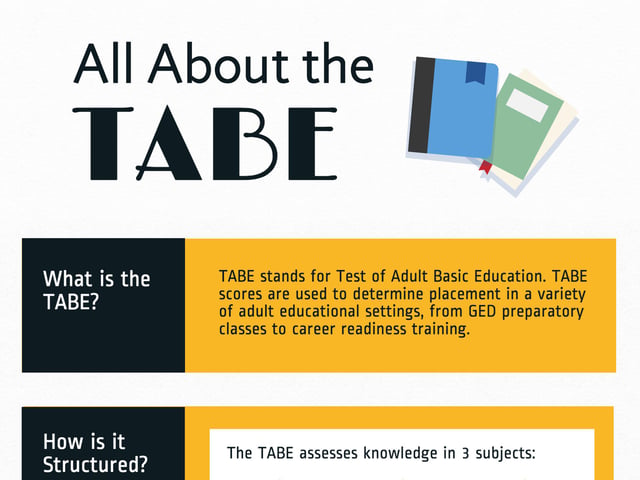
10 Tips to Increase Your TABE Test Score
Thanks to the Workforce Innovation and Opportunity Act, many people are eligible to take the TABE test to assess their current educational skills. The goal is to determine the best placement for various opportunities, including GED programs and trade schools.
Is the TABE test hard? The TABE test is not designed to trick or outsmart you. In fact, there’s no way to fail the TABE test.
That said, your score can determine the courses you’ll take in your educational or career journey. A higher score can get you one step closer to your ultimate goal.
This article will discuss ten tips to help you prepare for the TABE test. As always, our goal is to help you work smarter, not harder.
1. Use the Right Study Materials
Like many standardized tests, there are different versions of the TABE test, and the most common version is updated every few years. Currently, testing centers are offering the TABE 11 & 12. This version is designed to meet the needs of:
-
College and Career Readiness Standards
-
WIOA regulations
-
High school equivalency placement (i.e. GED courses)
-
Postsecondary placement
The three academic assessment areas on the TABE 11 & 12 are reading, language, and math. While these academic assessment areas were included in earlier versions of the test, they have been updated in terms of content. Therefore, you must ensure that your study materials are designed around the TABE 11 & 12 rather than an earlier version of the test that may have covered different subtopics.
2. Create a Study Schedule
Any successful study plan starts with a clearcut study schedule. Because there are three assessment areas on the TABE, you should give yourself a minimum of three weeks to study before your test date. We encourage you to start even earlier, giving yourself an additional week to review your study materials, particularly those areas you’ve struggled with the most.
How you approach your study schedule is up to you. You may want to devote one week at a time to individual assessment areas or divide your schedule so that you’re covering all subjects every week. No matter your approach, consider studying for no longer than 1-2 hours a day and building in 1-2 free days where you can relax and focus on other activities.
3. Consider Your Personal Energy Levels
Have you ever attempted to read a book or complete an assignment when you felt tired or distracted? If so, you know how hard it is to stay focused and absorb the information in front of you.
If there is flexibility in your day-to-day, schedule your study time based on your energy levels. Some people may find that they’re most alert in the mornings, while others may gain mental clarity in the late afternoon or evening. If you need an energy boost before your study session, consider 15 minutes of exercise or a 20-minute nap rather than caffeine, which may increase jitteriness and leave you feeling more distracted.
4. Create Your Ideal Study Space
Where you study should also depend on your personal preferences and the conditions that make you feel focused. That could be the desk in your bedroom or the kitchen table after the kids are at school or in bed. For some, background noise can help, and a local coffee shop or library may become your optimal study space.
How can you determine where you study best? The goal is to minimize distractions, including disruptions from other people. If necessary, remind your family members that you need 1-2 hours of disruption-free time and that they should only interrupt your study session if it’s an emergency.
5. Avoid Learning Fatigue
Learning fatigue makes staying on track difficult, no matter how organized your study schedule may be. The signs of learning fatigue are a lot like burnout, the symptoms of which include anxiety, fatigue, trouble sleeping, headaches, and a negative outlook.
If you’re experiencing learning fatigue, it’s time to take a break. Consider practicing mindfulness and calming techniques on the days you study to clear your mind and keep you focused on the positive. Helpful techniques can include yoga, meditation, breathing exercises, and light exercise, and you can find plenty of free resources for each on websites like YouTube.
6. Review TABE Study Guides
Reading, language, and math are broad subjects that you engage with every year of grade school. Trying to approach those subjects without guidance will become overwhelming, and you may spend a great deal of time reviewing skills and theories that won’t appear on the TABE test. Use TABE 11 & 12 study guides to ensure you’re reviewing the correct materials.
These study guides cover all levels of the TABE test except Level L, most of which is read to the student. Each study guide will include the concepts in TABE test levels, E, M, D, and A. There are also charts that tell you on which test level each concept is assessed. You’ll be able to move up to more difficult skills as you prepare to take the next level of the TABE test, and find all the information about that in one study guide. This organization also makes it easy to go back and review easier skills if you need help as you progress. Also, each TABE test level holds you responsible for skills tested at previous levels, so reviewing those will be easy, too.
7. Take Notes While You Study
When you’re reviewing your study guides, make sure that you’re taking notes, preferably handwritten. While engaging with the content by reading is the first step toward understanding the material, taking handwritten notes is a valuable tool for remembering the material.
This is because of encrypted embodied cognition, a fancy way of saying that writing down information by hand creates new pathways in your brain that make recall easier and faster. Even if you rewrite the information in your study guides by hand, you’re building on your memory of that material—and rephrasing that material in your own words will make your memory even stronger.
8. Incorporate a Variety of Study Methods
Engaging with test prep material in various ways is a great way to stay engaged and active while studying. Plus, it can make learning easier and more effective for students with unique learning styles.
One of our favorite alternative study methods is our TABE flashcards. These flashcards are a great way to turn your study session into an interactive game while testing your recall on a wide variety of subtopics that will appear on the TABE test. You can even ask a friend or family to quiz you using TABE flashcards if solo studying leaves you a little uninspired.
9. Take TABE Practice Tests
As you may recall, we encourage a study schedule that allows for one extra week of full TABE test review. Sure, you could spend that week covering every subtopic in your study guides and notes. However, there are other ways to approach a final review, and there are more effective uses of your time.
Schedule time to take a TABE practice test at least once, if not twice, before your official test date. Not only will this help you to get acquainted with the types of questions asked on the TABE test and the types of answers they’re expecting, but it will also help you to identify your current strengths and trouble areas. Then, you can use your review week to focus on your trouble areas and master the material you struggle with rather than spending an equal amount of time on the concepts you already have in the bag.
10. Don’t Cram at the Last Minute
We know what you may be thinking: spending three or more weeks preparing for one test is a lot. Couldn’t you knock out all of our TABE test prep materials in a few days or even a few hours? You could try, but there are more effective ways to prepare for a test, and you likely won’t achieve the high score that you could with a more rigorous study schedule.
Unlike many of the tests we take in grade school, the TABE covers a wide range of concepts and academic skills. Because you’ll need to demonstrate a strong awareness of three different assessment areas at challenging or advanced levels to achieve the highest score possible, cramming probably won’t give you the recall you need to get the job done. While cramming can spark your short-term memory, it doesn’t make an impact on your long-term memory.
Union Test Prep Is Here to Help You Succeed on the TABE Test
At Union Test Prep, we believe you should always work smarter, not harder. We know how busy your life is and how important the TABE test is to the next chapters of that busy life. That’s why we’ve worked hard to create free online test prep materials to help you succeed.
To get started, take a look at our free online TABE test prep materials. Create an account so you can access these materials and come back to them any time you need. We’ve got you, and you’ve got this!
Keep Reading

Test for Adult Basic Education Blog
How to Pass the TABE Test
Adult learners add an average of $7,500 per year to their salaries just…

Test for Adult Basic Education Blog
What is the TABE Test? Everything You Need to Know
Are you looking to develop your skills or acquire new ones? After many…

Test for Adult Basic Education Blog
The TABE: All About the Test
What is the TABE? TABE stands for Test of Adult Basic Education. TABE …